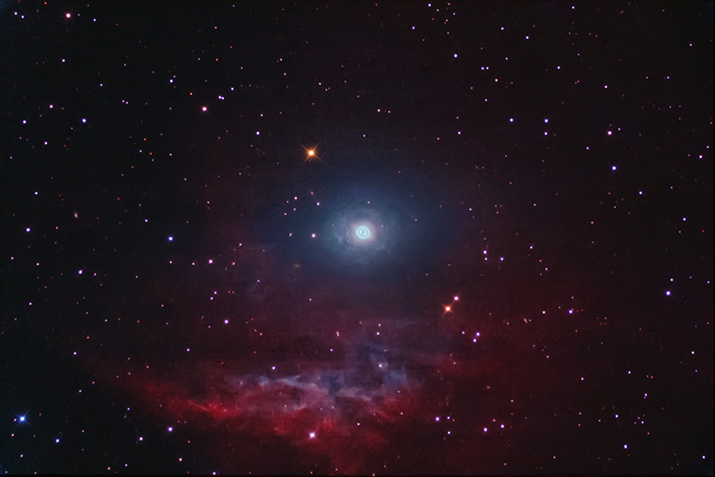
|
Image Credit: Data Acquisition - Ron DiIulio / Image Processing - Donald Waid
Guided using Innovations Foresight On Axis Guider (ONAG) Click on the image below to view at higher resolution. |

|
NGC 3242, commonly known as The Ghost of Jupiter, is a planetary nebula located in the constellation Hydra. The name refers to the resemblance of NGC 3242 to the planet Jupiter (in our solar system) in size and shape when observed in small telescopes.1,2 About the Ghost of Jupiter As a planetary nebula, The Ghost of Jupiter was most likely formed when a small to medium sized star used up its supply of stellar fuel at the end of its life cycle and began expelling its outer atmospheric layers in rings of nebulosity. In the death throes of stars of this size, this ejected matter continues to expand and diffuse into the interstellar medium, eventually setting the stage for the creation of new stars. At the end of the process, only the dense, extremely hot, core of the dying star remains1: a white dwarf star. Unable to support nuclear fusion, white dwarves cool to dead cinders of carbon and oxygen atoms1. As with The Ghost of Jupiter, this same fate awaits our own Sun in several billion years' time.1 Image Production The image above is the product of collaboration between Ron DiIulio and me as we observed NGC 3245 over several nights utilizing relatively moderate sized amateur equipment. The displayed image was processed as a bi-color image with Hydrogen Alpha data mapped to the red channel and Oxygen III data mapped to the green and blue channels. The stars were overlaid with data obtained from a separate RGB filtered image. This technique yields a near true color image. The result of this effort not only produced a pleasing pretty picture but also elements of some scientific interest. The bright nebula2 in the lower part of the image is thought to be either material ejected from NGC 3242 during its early red giant phase or possibly gas in the interstellar medium that is being excited by the intense radiation of the white dwarf. Amateur Astronomy Contribution The capability of utilizing amateur equipment and personnel to perform certain scientific studies can be a useful tool in aiding professional astronomers with their research endeavors. For example, additional observations using amateur spectroscopy equipment could shed light on the origin of this nebular material.
Member of the Dark Sky Observatory Collaborative
1https://www.constellation-guide.com/ghost-of-jupiter-nebula/
|